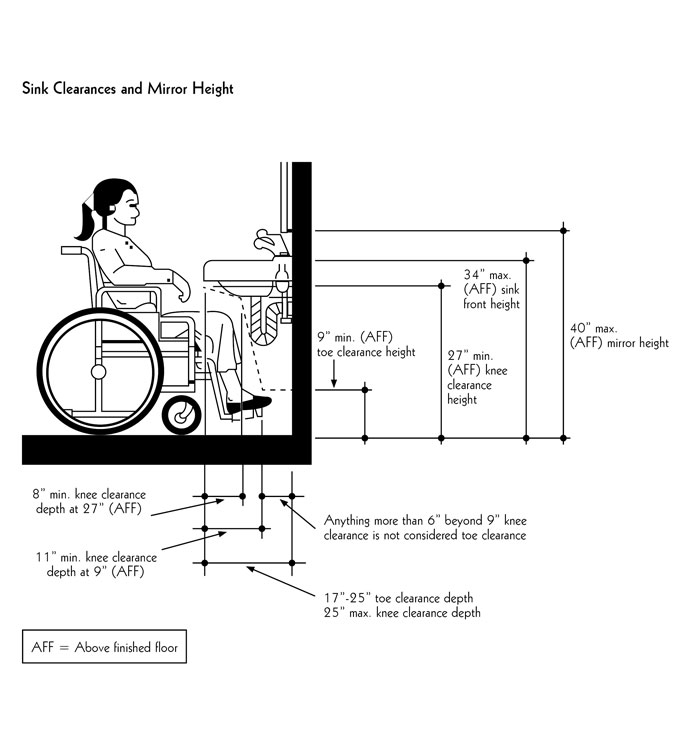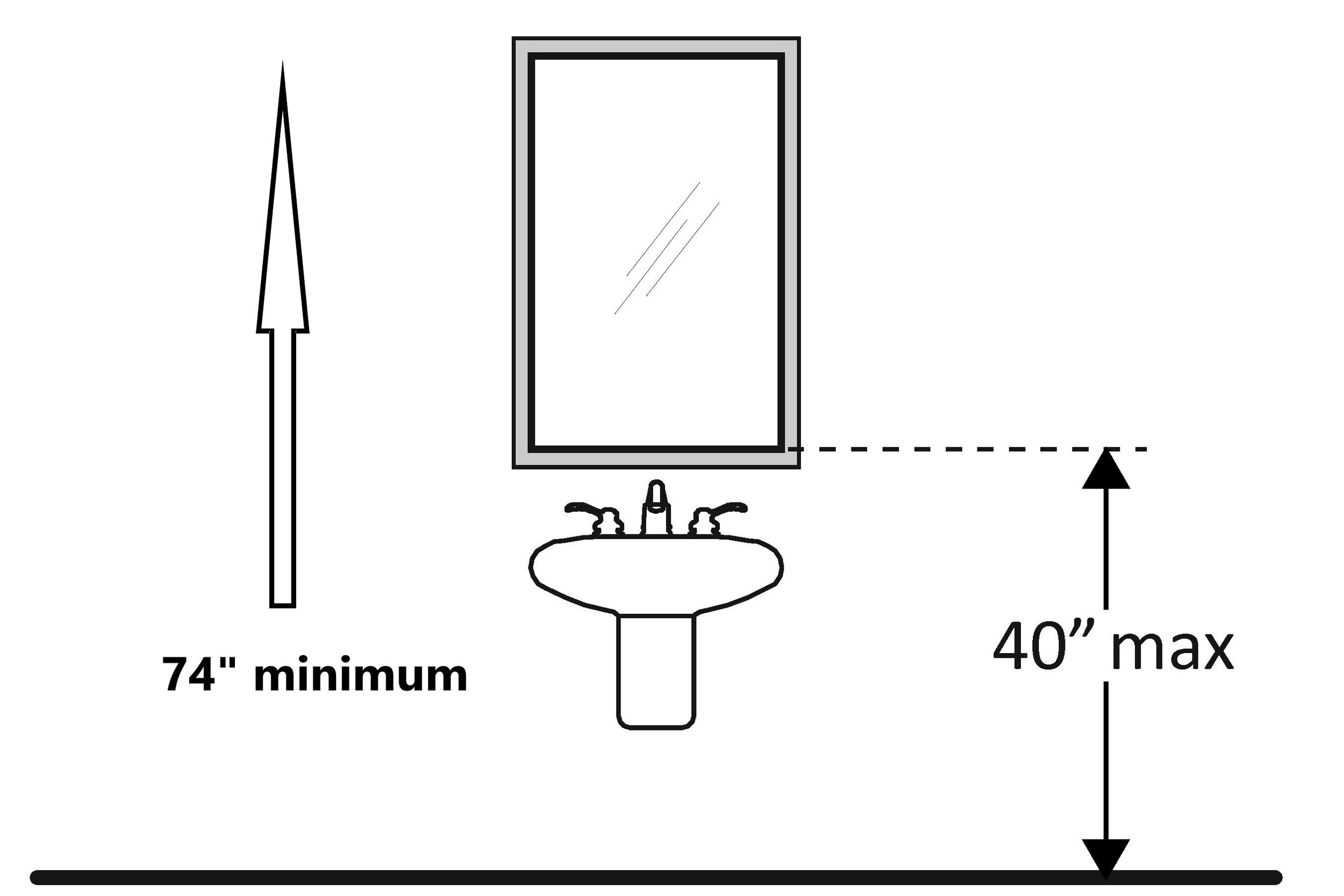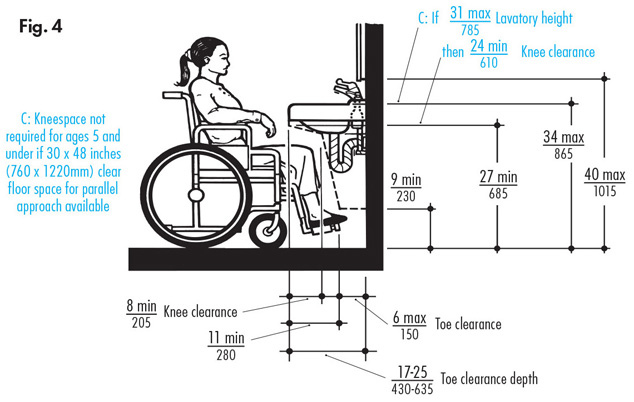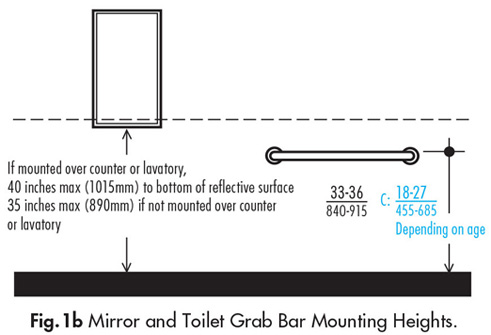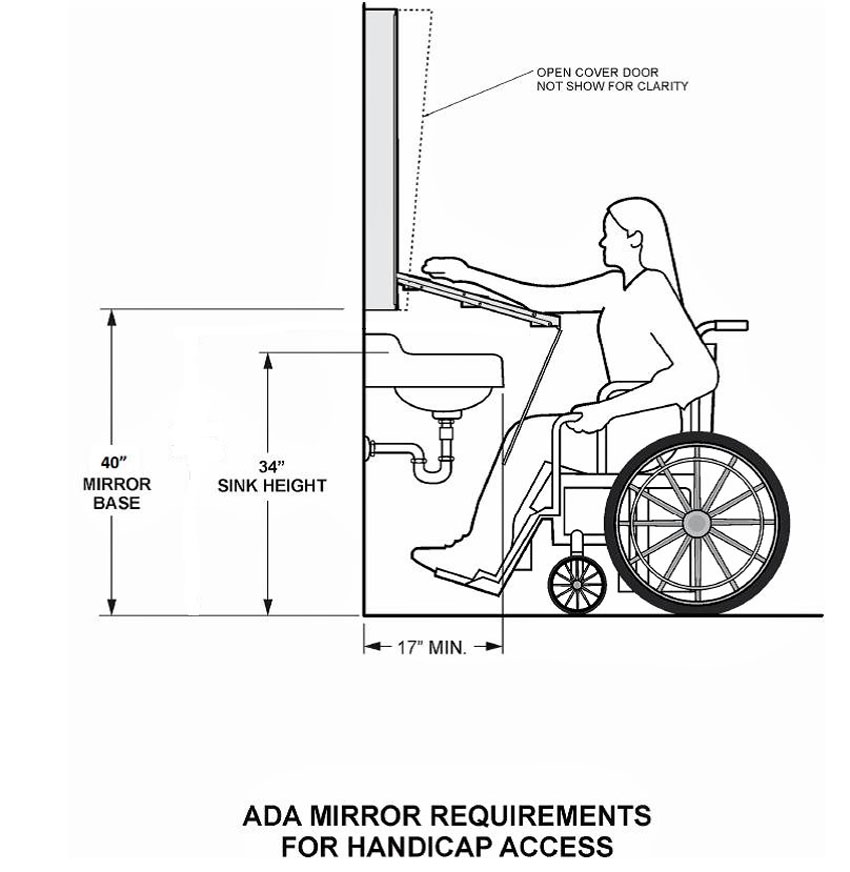Understanding ADA Bathroom Mirror Requirements
When it comes to designing accessible spaces, adhering to the guidelines set by the Americans with Disabilities Act (ADA) is crucial. Let’s talk about the specific requirements for ADA bathroom mirrors and explore why compliance is essential for creating inclusive environments.
- Reflecting on ADA Compliance: ADA bathroom mirror requirements go beyond aesthetics; they are designed to ensure accessibility for individuals with disabilities. These guidelines dictate the height, placement, and clear floor space in front of the mirror to accommodate wheelchair users and those with limited mobility.
- Height Matters: ADA regulations state that the bottom edge of the mirror should be mounted no higher than 40 inches from the floor. This ensures that individuals in wheelchairs can comfortably see their reflection without straining their necks or reaching too high. The maximum height requirement of the mirror is particularly important for individuals with varying degrees of mobility.
- Clear Floor Space: Another crucial aspect of ADA compliance is providing adequate clear floor space in front of the mirror. This allows individuals using mobility devices such as wheelchairs or walkers to position themselves comfortably and safely. The ADA recommends a clear floor space of at least 30 inches by 48 inches, with no obstructions within this area.
- Tilted Mirrors for Optimal Viewing: To further enhance accessibility, the ADA allows for the installation of tilted mirrors. These mirrors can be adjusted to meet the specific needs of individuals in wheelchairs or those with limited height or reach. Tilted mirrors provide a more comfortable viewing angle, ensuring that everyone can see themselves clearly and comfortably.
- Safety Considerations: In addition to height and clear floor space requirements, ADA-compliant bathroom mirrors should also meet safety standards. This includes using shatterproof materials or installing safety film on the mirror surface to prevent injury in case of breakage. It is important to prioritize the safety and well-being of all individuals, especially those with disabilities.
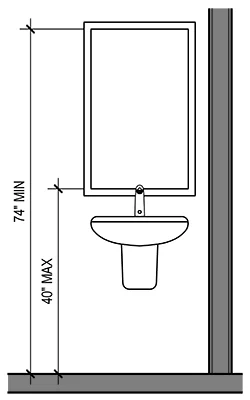
The Importance of ADA Compliance in Bathroom Mirror Design
Creating an inclusive and accessible environment is not only morally important but also a legal obligation. We will explore the significance of ADA compliance in bathroom mirror design and the positive impact it has on individuals with disabilities.
Equal Access for All: ADA compliance ensures that individuals with disabilities have equal access to essential facilities, such as bathrooms. By following ADA guidelines for bathroom mirror design, we create an environment where everyone can comfortably and confidently use the facilities, regardless of their abilities.
Independence and Dignity: Accessible bathroom mirror design promotes independence and preserves the dignity of individuals with disabilities. By providing mirrors at appropriate heights and with adequate clear floor space, individuals can use the facilities without assistance, fostering a sense of autonomy and empowerment.
Enhanced User Experience: ADA-compliant bathroom mirrors enhance the overall user experience for individuals with disabilities. By considering their specific needs and implementing accessible design features, such as tilted mirrors or anti-glare coatings, we ensure that everyone can easily see themselves and attend to their personal grooming needs.
Legal Compliance: Meeting ADA requirements is not optional; it is a legal obligation. Non-compliance can result in legal consequences and penalties. By adhering to ADA guidelines for bathroom mirror design, businesses, and organizations not only avoid legal troubles but also demonstrate their commitment to inclusivity and accessibility.
Positive Reputation: Creating an accessible space with ADA-compliant bathroom mirrors can have a positive impact on an organization’s reputation. By prioritizing accessibility, businesses show their commitment to diversity and inclusivity, attracting a wider range of customers and clients who value accessibility and social responsibility.
Key Specifications for ADA-Compliant Bathroom Mirrors
ADA-compliant bathroom mirrors are designed to ensure accessibility and inclusivity for individuals with disabilities. Below are the key specifications that make a mirror ADA-compliant, providing a comprehensive understanding of the requirements.
Height Requirements: ADA guidelines state that the bottom edge of the mirror should not be mounted higher than 40 inches from the floor. This allows individuals in wheelchairs or with limited mobility to comfortably view themselves without straining or reaching too high.
Clear Floor Space: To accommodate individuals using mobility devices, ADA-compliant bathroom mirrors require a clear floor space of at least 30 inches by 48 inches in front of the mirror. This space should be free from any obstructions, ensuring easy access for wheelchair users.
Tilted Mirrors: While not a mandatory requirement, installing tilted mirrors is highly recommended for ADA compliance. Tilted mirrors can be adjusted to suit the needs of individuals with varying heights or those using wheelchairs, providing a more comfortable viewing angle.
Safety Considerations: ADA-compliant bathroom mirrors should prioritize safety. Using shatterproof materials or applying safety film to the mirror surface minimizes the risk of injury in case of breakage. Safety measures ensure the well-being of all individuals, including those with disabilities.
Mounting and Installation: ADA guidelines also provide specifications for the mounting and installation of bathroom mirrors. Mirrors should be securely mounted to prevent accidents or injuries. Additionally, mirrors should not have sharp or abrasive edges that could pose a safety hazard.
Design Tips for ADA-Approved Mirrors
Designing ADA-approved mirrors requires careful consideration of accessibility and inclusivity. Here are some essential design tips that can help create functional and aesthetically pleasing bathroom mirrors that meet ADA requirements.
Size and Placement: Ensure that the mirror is large enough to provide a clear reflection for individuals with different abilities. Consider the specific needs of wheelchair users and individuals with limited mobility when determining the size and placement of the mirror. Aim for a mirror that is easily accessible and visible from various angles.
Anti-Glare Coatings: To improve visibility and reduce glare, consider using anti-glare coatings on the mirror surface. This helps individuals with visual impairments or sensitivity to light to see themselves more clearly and comfortably.
Adjustable Tilt Mechanisms: Installing mirrors with adjustable tilt mechanisms allows for customization based on individual needs. This feature is particularly beneficial for individuals in wheelchairs or those with limited height or reach. Adjustable tilt mechanisms ensure a comfortable viewing angle for all users.
Lighting Considerations: Proper lighting is crucial for ADA-approved bathroom mirrors. Ensure that the mirror area is well-lit, with evenly distributed lighting to minimize shadows and enhance visibility. Consider incorporating task lighting or ambient lighting to improve the overall user experience.
Material Selection: Choose materials that are not only aesthetically pleasing but also durable and easy to maintain. Opt for materials that are resistant to moisture, stains, and corrosion. Consider using impact-resistant materials or applying safety film to ensure the mirror’s durability and safety.
Choosing the Perfect ADA Bathroom Mirror
Selecting the right ADA bathroom mirror involves considering both functional and aesthetic factors. We will explore some key considerations to help you choose the perfect ADA-compliant mirror for your space.
ADA Compliance: First and foremost, ensure that the mirror meets all ADA requirements for height, clear floor space, and safety. Check that it is designed to accommodate individuals with disabilities and provides an inclusive experience for all users.
Size and Proportion: Consider the size and proportion of the mirror in the overall bathroom space. Ensure that the mirror is not too small or too large, but rather proportionate to the surrounding fixtures and the needs of the users.
Style and Aesthetics: While functionality is essential, don’t overlook the mirror’s aesthetic appeal. Choose a mirror that complements the overall bathroom design and reflects the desired style. Consider different shapes, frames, and finishes to find a mirror that enhances the visual appeal of the space.
Reflective Surface Quality: Opt for a mirror with a high-quality reflective surface that provides a clear and distortion-free image. Ensure that the mirror reflects true colors and enhances the overall lighting in the bathroom.
Ease of Maintenance: Consider the maintenance requirements of the mirror. Choose materials that are easy to clean and maintain, ensuring that the mirror retains its functionality and aesthetics over time.
Accessories in Public Restrooms ADA Guidelines – Harbor City Supply
ADA Inspections Nationwide, LLC u2014 ADA Compliancy
ADA Bathroom Planning Guide – Mavi New York
ADA Bathroom Planning Guide – Mavi New York
ADA Compliant Bathroom: Sinks and Restroom Accessories – LaForce, LLC
Bathroom Measurement Guide: These are the Measurements You Need to
CE Center – Healing Environments for Health Care
ADA Accessible Single User Toilet Room Layout and Requirements
Related Posts:
